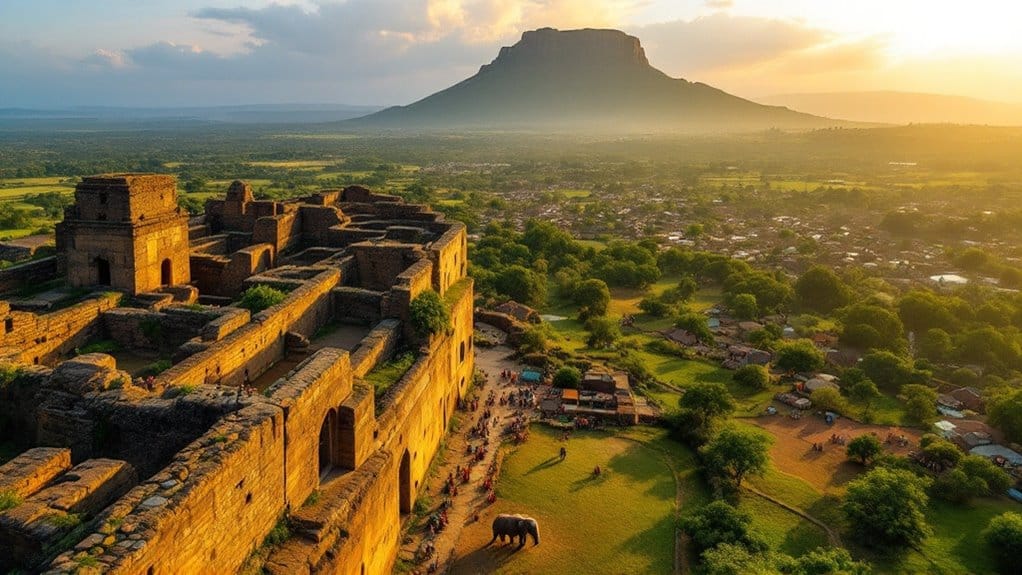When you think about visiting Africa, the continent's influential civilizations and sites might not be the first things that come to mind. Yet, these remarkable locations offer profound insights into the historical complexities and innovations of societies like the Kingdom of Kush or the Mali Empire. Each site stands as a symbol of human achievement and cultural exchange, inviting you to reflect on their legacies. But what specific stories do these ancient places hold, and how do they connect to the world we live in today?
Key Takeaways
- Explore the architectural marvels of the Kingdom of Kush and Aksum, including their impressive pyramids and monumental obelisks.
- Experience the rich cultural heritage of Timbuktu, a historical center of Islamic scholarship and trade during the Mali Empire.
- Discover the economic legacies of the Mali and Songhai empires, which dominated gold and salt trade routes across Africa.
- Visit Great Zimbabwe's stunning stone structures, showcasing advanced building techniques and urban planning of the Shona civilization.
- Engage with the historical significance of ancient Egypt, renowned for its monumental achievements and groundbreaking contributions to various fields.
Kingdom of Kush and Aksum
As you explore the rich tapestry of Africa's history, you'll discover the remarkable Kingdom of Kush and its successor, Aksum, both of which played pivotal roles in shaping the continent's cultural and economic landscape.
The Kingdom of Kush, located in present-day Sudan, thrived for over a thousand years, peaking during the second millennium B.C. Its legacy includes over 200 pyramids, even surpassing those of Egypt, showcasing its architectural prowess and cultural significance.
Transitioning into the era of Aksum, which emerged as a powerful trade center around the 2nd and 3rd centuries A.D., you'll find a civilization that connected Europe and the East. Aksum is celebrated for its monumental stone obelisks, some towering over 100 feet, symbolizing its architectural achievements.
The introduction of the Geez script marked a significant moment in African literacy, while the adoption of Christianity in the 4th century solidified its alliances with the Byzantine Empire.
Together, these civilizations not only enhanced trade between sub-Saharan Africa and the Mediterranean but also left enduring legacies that continue to captivate and inspire those who seek to understand Africa's rich history.
Mali and Songhai Empires
The Mali and Songhai Empires thrived on their strategic control of trade routes, turning gold and salt into keys to immense wealth.
As you explore their legacies, you'll find cities like Timbuktu and Gao not only bustling with commerce but also rich in culture and education, attracting scholars from far and wide.
These empires didn't just shape economies; they laid the groundwork for a vibrant exchange of ideas and traditions that still resonate today.
Economic Prosperity and Trade
Throughout history, the Mali and Songhai Empires stand out for their remarkable economic prosperity and trade networks that shaped not only Africa but also global commerce.
The Mali Empire, flourishing between the 13th and 16th centuries, harnessed its control over essential trade routes to amass great wealth, especially from gold and salt. Mansa Musa, the empire's most famous ruler, is legendary for his 1324 pilgrimage to Mecca, which displayed his riches and even impacted economies as far as Egypt through the lavish distribution of gold.
As the Mali Empire evolved, the Songhai Empire rose to prominence in the 15th century, becoming one of Africa's largest empires. It capitalized on the existing trade routes while emphasizing military strength to reinforce its economic dominance.
Timbuktu emerged as a significant city in both empires, functioning as a hub for trade and knowledge. This vibrant center attracted traders from Europe and the Middle East, enhancing the region's prosperity.
The economic interactions among these civilizations and external entities highlight their important role in shaping global trade networks, making them essential destinations for anyone interested in Africa's rich history.
Cultural and Educational Centers
Timbuktu stands as a shimmering beacon of knowledge and culture from the Mali and Songhai Empires, drawing scholars and traders alike from across the Islamic world.
During the height of the Mali Empire, from the 13th to 16th centuries, this vibrant city transformed into a major cultural and educational center. It was home to the renowned Sankore University, a crucial institution that fostered Islamic scholarship and boasted an extensive collection of historical manuscripts.
As the Songhai Empire rose to prominence, it further enhanced Timbuktu's status, emphasizing military strength and administrative efficiency. This period solidified Timbuktu's reputation as an essential hub for learning and trade, where ideas and cultures converged.
The trade routes connecting sub-Saharan Africa to Europe and the East facilitated not just commerce but also cultural exchanges, influencing the broader Islamic world.
Today, you can still witness the remarkable legacy of the Mali and Songhai Empires through Timbuktu's rich historical architecture and its priceless manuscripts.
Visiting this legendary city allows you to connect with a profound past, celebrating the cultural and educational achievements that shaped the region and continue to inspire scholars and travelers alike.
Great Zimbabwe's Legacy
Great Zimbabwe stands as a tribute to the ingenuity of its builders, with its stunning stone structures like the Great Enclosure showcasing remarkable architectural skills.
As you explore its rich history, you'll uncover how this thriving empire connected trade routes to coastal cities, fueling an economy based on gold, cattle, and agriculture.
This legacy not only highlights the sophistication of African civilizations but also reshapes our understanding of their historical significance.
Architectural Marvels Exploration
When you step into the world of Great Zimbabwe, you're greeted by the stunning remnants of a civilization that flourished from the 11th to the 15th centuries. This ancient city, a UNESCO World Heritage site, showcases impressive stone structures like the Great Enclosure and the Hill Complex, revealing the advanced architectural techniques of the Shona civilization.
The walls, constructed without mortar, are made primarily of granite stone and exemplify the intricate craftsmanship and engineering capabilities of their builders. As you wander through these ruins, you can't help but appreciate the significance of Great Zimbabwe as a thriving metropolis, supporting around 18,000 people at its peak.
To appreciate its architectural marvels, consider the following aspects:
| Structure | Features | Significance |
|---|---|---|
| Great Enclosure | Massive stone walls, intricate designs | Symbol of power and wealth |
| Hill Complex | Elevated structures, ceremonial sites | Spiritual and cultural importance |
| Dry Stone Walls | No mortar used, precise construction | Engineering prowess |
| Ruins Preservation | UNESCO recognition | Cultural heritage representation |
Visiting Great Zimbabwe offers a glimpse into the rich history of African civilizations, challenging stereotypes about their advanced societal structures.
Trade and Economy Insights
As you explore the architectural wonders of Great Zimbabwe, you'll soon discover that its impressive structures were more than just symbols of power; they were integral to a vibrant trade and economy that flourished between the 11th and 15th centuries.
This remarkable city thrived as a substantial trading empire, connecting the rich inland resources with coastal trade routes, especially those leading to Sofala on the Indian Ocean.
The economy of Great Zimbabwe was primarily driven by trade in gold, ivory, and cattle—essential commodities that attracted regional and international merchants.
With an estimated population of 10,000 to 20,000 people, the city stood as a bustling urban center and a critical trade hub, bustling with activity and cultural exchange.
Archaeological findings reveal that the stone structures, including the Great Enclosure, weren't only architectural marvels but also symbols of the wealth generated through these trade activities.
The legacy of Great Zimbabwe's extensive trade networks considerably influenced the rise of subsequent regional powers and remains a focal point for understanding the economic history of Southern Africa.
Carthaginian Empire Insights
Rising to prominence from its roots in the ancient Phoenician city of Carthage, the Carthaginian Empire carved out a dominant presence across the western Mediterranean between the 9th and 2nd centuries BCE.
This empire thrived by establishing an intricate network of trade routes, connecting diverse cultures and economies. As you explore this influential civilization, you'll discover how Carthage's strategic location allowed it to control essential trade arteries, leading to a flourishing economy based on textiles, metals, and agricultural products.
Carthage wasn't just a commercial hub; its military prowess was equally formidable. Engaging in the infamous Punic Wars against Rome, the empire showcased its strength through legendary figures like Hannibal, who captured imaginations with his audacious crossing of the Alps.
The Carthaginian Empire's ability to project power and maintain trade dominance made it one of the wealthiest cities of the ancient world.
However, the eventual destruction of Carthage in 146 BCE marked a pivotal moment, paving the way for Roman expansion.
Visiting the ruins of this once-great civilization offers a glimpse into a world of commerce and conquest that shaped the Mediterranean's historical landscape.
The Golden Age of Timbuktu
During the 15th and 16th centuries, Timbuktu flourished as a beacon of knowledge and culture in West Africa, drawing scholars and traders from across the Islamic world. This vibrant city became a hub of scholarship, where the prestigious Sankore University and numerous libraries thrived, attracting minds enthusiastic to share and expand upon Islamic thought. Timbuktu wasn't just a center for learning; it was also essential in the trans-Saharan trade network, facilitating the exchange of goods and ideas between Africa, Europe, and the Middle East.
| Feature | Significance | Example |
|---|---|---|
| Islamic Schools | Centers for higher learning | Sankore University |
| Mosques | Architectural marvels | Djinguereber, Sidi Yahia |
| Trade Population | Indicates economic importance | Up to 100,000 during peak trade |
| Cultural Exchange | Fosters interaction and innovation | Goods and ideas shared globally |
| Influence on Thought | Shaped Islamic scholarship | Development of new philosophies |
As you explore Timbuktu, you'll uncover its rich history, where trade and scholarship intertwined, leaving a lasting legacy that continues to inspire today.
Discovering the Land of Punt
The Land of Punt, often referred to as the "Land of the Gods," captures the imagination with its legendary wealth and exotic treasures. Documented in Egyptian records dating back to 2500 B.C., Punt was a crucial trading partner for ancient Egypt, especially during Queen Hatshepsut's reign.
Exploring Punt offers a glimpse into a world rich in resources and cultural exchange.
Here are three intriguing aspects of Punt:
- Wealth of Resources: Punt was renowned for its ebony, gold, myrrh, and exotic animals, all of which were highly sought after by the Egyptians.
- Cultural Significance: The artifacts and records from Punt highlight its influence on Egyptian art and religion, underscoring the interconnectedness of ancient civilizations.
- Mystery Surrounding Its Location: While the precise location of Punt remains debated, theories suggest it might've been along the Red Sea coast of East Africa, possibly in today's Eritrea or Ethiopia.
Research on mummified baboons has further linked Punt to ancient East African regions, revealing the extent of trade and interaction between ancient Egypt and its southern neighbors.
Discovering Punt is an adventure into the depths of ancient history and trade.
Ancient Egypt's Influence
Ancient Egypt stands as one of history's most remarkable civilizations, leaving an indelible mark on the world through its monumental achievements and profound cultural influence. The iconic pyramids and temples serve as a demonstration of their advanced engineering and artistry, enchanting visitors even today.
As you explore these ancient wonders, you'll be reminded of how Ancient Egypt laid the groundwork for great civilizations that followed.
The complexity of their writing system, hieroglyphics, was pivotal in record-keeping and governance, showcasing the civilization's sophisticated approach to administration. This innovation in communication not only shaped African history but also influenced cultures around the globe.
Moreover, Ancient Egyptians made groundbreaking advancements in medicine, mathematics, and engineering, establishing principles that would echo through time. Their rich religious practices, centered around the worship of deities and beliefs about the afterlife, have resonated with various cultures, contributing to a shared spiritual heritage.
Lastly, the artistic legacy of Ancient Egypt, defined by realism and symbolism, continues to inspire modern art and architecture, reflecting the enduring power of their creativity.
Visiting these sites, you'll witness firsthand the lasting influence of Ancient Egypt on our world.
The Rich Heritage of Africa
Exploring the remarkable legacy of Ancient Egypt naturally leads to a broader appreciation of Africa's rich heritage, which encompasses a tapestry of influential civilizations and monumental achievements.
As you investigate deeper, you'll uncover:
- The Kingdom of Kush: Home to over 200 pyramids, this kingdom boasts more pyramids than Egypt, showcasing a significant architectural heritage.
- The Mali Empire: Under Mansa Musa, Timbuktu flourished as a cultural and educational hub during the 15th and 16th centuries, promoting Islamic scholarship and stunning architecture.
- Great Zimbabwe: Renowned for its impressive stone structures, this civilization thrived as a trading empire from the 11th to 15th centuries, leaving a lasting legacy.
The Kingdom of Aksum, with its monumental stone obelisks, even contributed to early written language through the development of the Geez script.
Ancient cities like Meroe and Leptis Magna reveal rich cultural exchanges and trade networks that facilitated the growth of these influential civilizations.
Each site tells a story, inviting you to explore the profound impacts Africa's heritage has had on the world.
Don't miss the chance to experience this extraordinary legacy firsthand.
Frequently Asked Questions
Why Are African Civilizations Important?
African civilizations are essential because they laid the groundwork for ancient empires that shaped global history.
You'll find rich cultural heritage in their art, architecture, and traditions. The indigenous knowledge passed down through generations offers insights into sustainable practices and community living.
Archaeological discoveries reveal sophisticated societies, trade networks, and intellectual hubs. Understanding these civilizations helps you appreciate their significant contributions to economics, governance, and culture, influencing the world as we understand it today.
Why Is Africa Important in World History?
Africa's like a vibrant tapestry, woven with threads of cultural heritage and ancient trade routes.
Its historical empires, from Egypt to Mali, have left profound impacts on human civilization, influencing governance, architecture, and scholarship.
You'll discover archaeological discoveries that disclose the continent's rich past, revealing stories of innovation and resilience.
Understanding Africa's importance in world history not only enriches your knowledge but also deepens your appreciation for the interconnectedness of our global heritage.
What Did the African Civilization Contribute to the World?
African civilizations contributed immensely to the world through ancient innovations, architectural marvels, and vibrant trade networks.
You'll discover how the Kingdom of Mali's wealth transformed economies and how Great Zimbabwe showcased advanced structures.
Cultural exchange flourished in cities like Timbuktu, where knowledge thrived, attracting scholars globally.
Additionally, the Carthaginian Empire's military tactics and trade routes reshaped Mediterranean connections, illustrating Africa's profound impact on global history and cultural development.
What African Country Has the Most Interesting History?
So, you think the ancient kingdoms of Africa aren't interesting? Let's talk about Ethiopia!
With its rich cultural heritage and historical sites, it's a treasure trove of stories.
You'll discover how the Kingdom of Aksum influenced trade and even Christianity, all while maneuvering through the colonial impact that shaped its modern identity.
Each stone you touch connects you to a vibrant past, proving that Africa's history is anything but boring!
Conclusion
Visiting Africa's influential civilizations and sites is like stepping into a vivid tapestry woven with threads of history, culture, and innovation. Each location whispers tales of greatness, inviting you to explore the legacies of powerful empires and vibrant cities. As you walk among ancient ruins and bustling markets, you'll feel the pulse of a continent rich in stories, where the past dances with the present. Don't just witness history—become a part of it and let Africa's heritage ignite your imagination.








